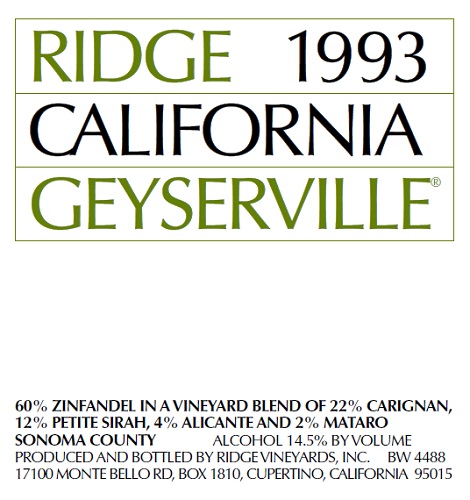
1993 Geyserville
Wine Information
60% Zinfandel, 22% Carignan, 12% Petite Sirah, 4% Alicante, and 2% Mataro
Vintage
1993
Vineyard
Geyserville
Appellation
Alexander Valley
Alcohol By Volume
14.5%
Winemaker Tasting Notes
Ruby, hints of purple. Guava, passion fruit. Sweet vanilla,spice, wood aromatics. Complex and exotic, with underlying elements of blueberry, candied orange rind, ripe peach, raspberry, mint. Vanilla, raspberry, blueberry. Beautifully defined briar/ bramble component. Peach and peach stone, slight earthiness. Elegant and balanced, firm acid— an exquisite wine. Drink now or hold. Or both.
Vintage Notes
Since 1966—and our first wine from this exceptional vineyard—we have made a Geyserville in every vintage. The late spring and cool nights in ’93 pushed back the growing season, but warm days toward the end of September fully ripened the fruit. In November, we tasted the separate lots from each of sixteen small fermentors, assembling the best to make this rich, elegant wine. As is typical with the Geyserville, it is both approachable and enjoyable as a young wine. Its chalky tannins add structure, and the potential for extended aging.
History
In 1990, after producing twenty-five vintages of this great single-vineyard wine, we were able to lease the old Whitten Ranch portion of the Trentadue family’s Geyserville vineyard. All the zinfandel—with the exception of two detached blocks—is planted on the thirty-six leased acres, guaranteeing that we will have these exceptional grapes for several decades to come.
Growing Season
In 1993, the first grapes to ripen on the Geyserville vineyard are usually harvested in the first or second week of September. With 1993’s late spring, the growing season began two weeks late; picking—even on the 25-year-old Whitten Ranch vines—did not begin until September 23. By month’s end, the19th-century zinfandel was ripe, as was the mixed Whitten block called Old Patch. The young zinfandel and mátaro followed. The Geyserville harvest ended on October 5, when we picked the very old carignan and fortyyear-old petite sirah. The grapes were fully ripe, with excellent acidity
Winemaking
We fermented, as usual, on the natural yeast, using sixteen small tanks to keep the blocks separate. The traditional submerged-cap method—grapes held below the surface of the juice—was used on a third of these; the remainder floated in their liquid, with gentle pump-overs. After a full, natural malolactic, we began assemblage in early November. Tasting eleven times over a period of three weeks, we combined the best lots to make the ’93 Geyserville. In December, the wine was racked to air-dried american oak barrels, twenty-five percent of which were new. In spring and fall of ’94 we tasted again—with and without small amounts of petite sirah and carignan, which had been held out. We determined that they contributed further complexity, and included them. The 1993 shows the elegance and firm structure typical of these gravelly soils. Rich berry fruit and lively, peppery spice combine with the chalky tannins to give us yet another extremely worthy vintage.
Consumer Tasting Notes
Average Rating: 88.9
No. of Tasting Notes: 25
View this wine on CellarTracker
Food Pairings
See all food pairing recipes we have created specifically for this wine.
See pairingsWait!
In order to qualify for user related discounts, you must log in before proceeding with checkout. Click the button below to log in and receive these benefits, or close the window to continue.
Log In